A Comprehensive Analysis of Australia's Better Access Scheme
VerifiedAdded on 2022/09/08
|10
|2187
|21
Report
AI Summary
This report critically analyzes the Australian Better Access Scheme, a mental health program aimed at improving access to care. It evaluates the program's success and failure, particularly in remote and rural areas, considering factors like geographic location, socio-economic status, and the uptake of services. The analysis highlights disparities in treatment and service availability, identifying key issues such as co-payment rates and the need for more practitioners in underserved regions. Recommendations are provided to improve the program, including adjustments to co-payment policies, incentives for practitioners, and training in innovative practice models. Furthermore, the report discusses broader recommendations for improving the Australian healthcare system and speculates on the future of both healthcare and the Better Access program, including the adoption of new technologies and care delivery models.
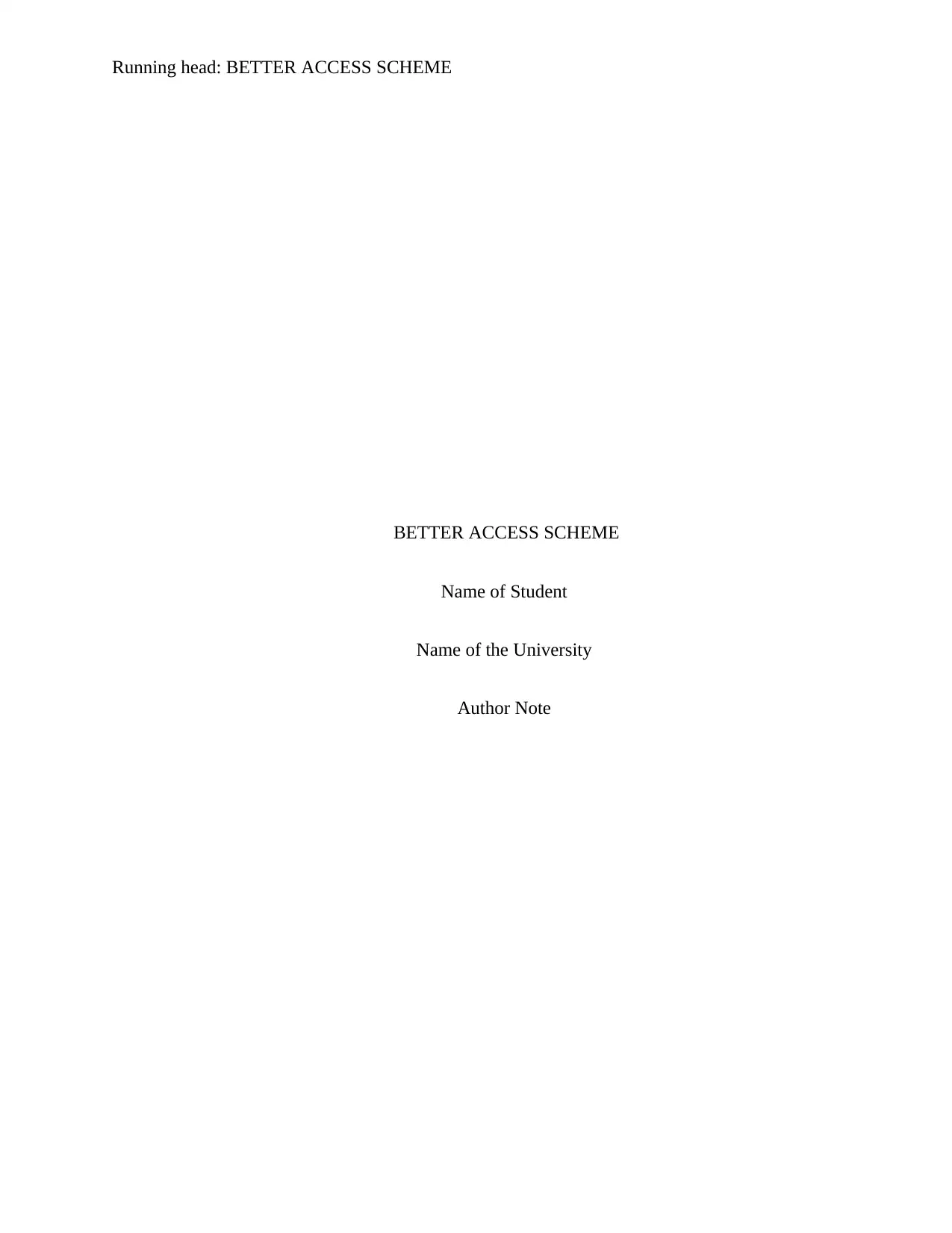
Running head: BETTER ACCESS SCHEME
BETTER ACCESS SCHEME
Name of Student
Name of the University
Author Note
BETTER ACCESS SCHEME
Name of Student
Name of the University
Author Note
Paraphrase This Document
Need a fresh take? Get an instant paraphrase of this document with our AI Paraphraser
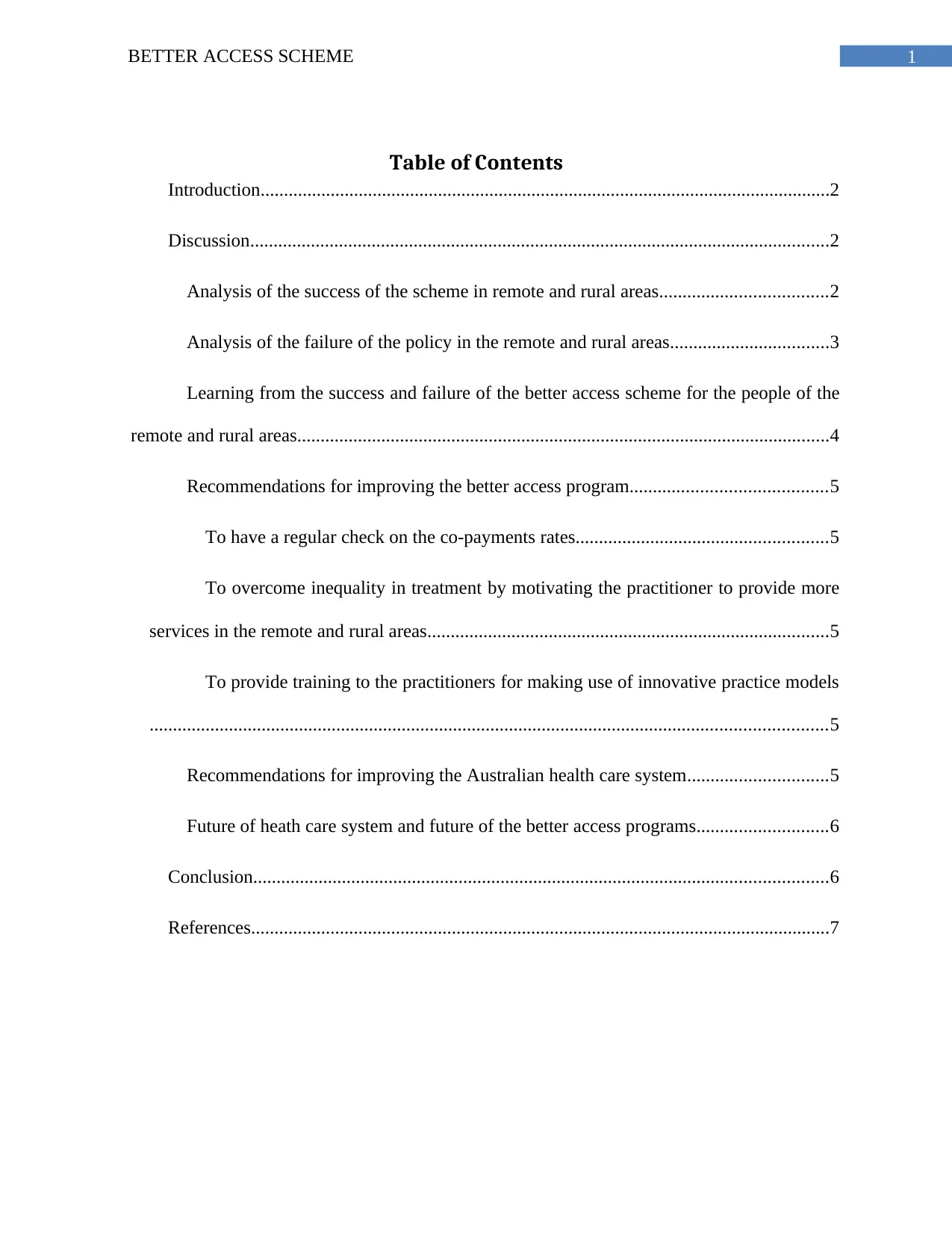
1BETTER ACCESS SCHEME
Table of Contents
Introduction..........................................................................................................................2
Discussion............................................................................................................................2
Analysis of the success of the scheme in remote and rural areas....................................2
Analysis of the failure of the policy in the remote and rural areas..................................3
Learning from the success and failure of the better access scheme for the people of the
remote and rural areas..................................................................................................................4
Recommendations for improving the better access program..........................................5
To have a regular check on the co-payments rates......................................................5
To overcome inequality in treatment by motivating the practitioner to provide more
services in the remote and rural areas......................................................................................5
To provide training to the practitioners for making use of innovative practice models
.................................................................................................................................................5
Recommendations for improving the Australian health care system..............................5
Future of heath care system and future of the better access programs............................6
Conclusion...........................................................................................................................6
References............................................................................................................................7
Table of Contents
Introduction..........................................................................................................................2
Discussion............................................................................................................................2
Analysis of the success of the scheme in remote and rural areas....................................2
Analysis of the failure of the policy in the remote and rural areas..................................3
Learning from the success and failure of the better access scheme for the people of the
remote and rural areas..................................................................................................................4
Recommendations for improving the better access program..........................................5
To have a regular check on the co-payments rates......................................................5
To overcome inequality in treatment by motivating the practitioner to provide more
services in the remote and rural areas......................................................................................5
To provide training to the practitioners for making use of innovative practice models
.................................................................................................................................................5
Recommendations for improving the Australian health care system..............................5
Future of heath care system and future of the better access programs............................6
Conclusion...........................................................................................................................6
References............................................................................................................................7
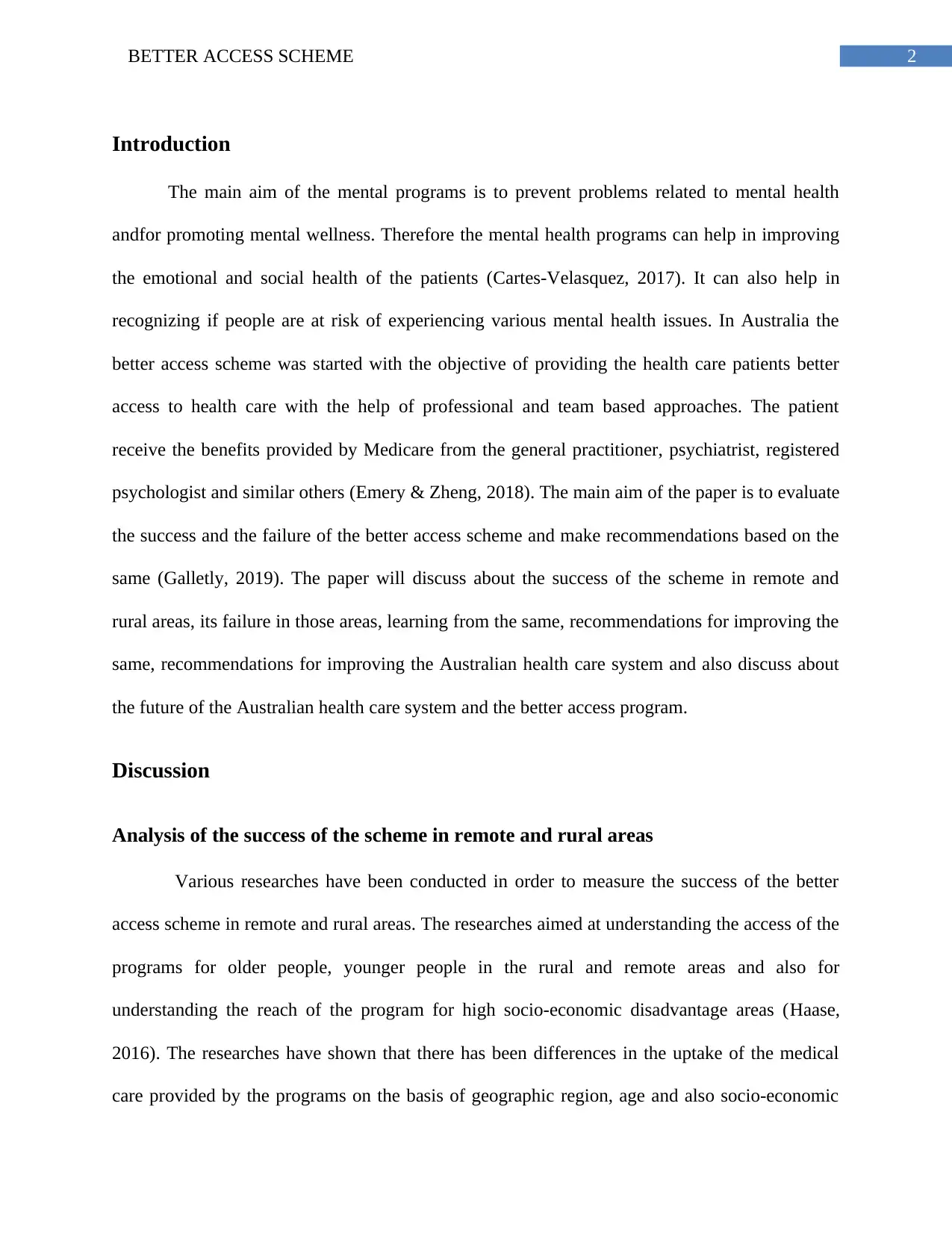
2BETTER ACCESS SCHEME
Introduction
The main aim of the mental programs is to prevent problems related to mental health
andfor promoting mental wellness. Therefore the mental health programs can help in improving
the emotional and social health of the patients (Cartes-Velasquez, 2017). It can also help in
recognizing if people are at risk of experiencing various mental health issues. In Australia the
better access scheme was started with the objective of providing the health care patients better
access to health care with the help of professional and team based approaches. The patient
receive the benefits provided by Medicare from the general practitioner, psychiatrist, registered
psychologist and similar others (Emery & Zheng, 2018). The main aim of the paper is to evaluate
the success and the failure of the better access scheme and make recommendations based on the
same (Galletly, 2019). The paper will discuss about the success of the scheme in remote and
rural areas, its failure in those areas, learning from the same, recommendations for improving the
same, recommendations for improving the Australian health care system and also discuss about
the future of the Australian health care system and the better access program.
Discussion
Analysis of the success of the scheme in remote and rural areas
Various researches have been conducted in order to measure the success of the better
access scheme in remote and rural areas. The researches aimed at understanding the access of the
programs for older people, younger people in the rural and remote areas and also for
understanding the reach of the program for high socio-economic disadvantage areas (Haase,
2016). The researches have shown that there has been differences in the uptake of the medical
care provided by the programs on the basis of geographic region, age and also socio-economic
Introduction
The main aim of the mental programs is to prevent problems related to mental health
andfor promoting mental wellness. Therefore the mental health programs can help in improving
the emotional and social health of the patients (Cartes-Velasquez, 2017). It can also help in
recognizing if people are at risk of experiencing various mental health issues. In Australia the
better access scheme was started with the objective of providing the health care patients better
access to health care with the help of professional and team based approaches. The patient
receive the benefits provided by Medicare from the general practitioner, psychiatrist, registered
psychologist and similar others (Emery & Zheng, 2018). The main aim of the paper is to evaluate
the success and the failure of the better access scheme and make recommendations based on the
same (Galletly, 2019). The paper will discuss about the success of the scheme in remote and
rural areas, its failure in those areas, learning from the same, recommendations for improving the
same, recommendations for improving the Australian health care system and also discuss about
the future of the Australian health care system and the better access program.
Discussion
Analysis of the success of the scheme in remote and rural areas
Various researches have been conducted in order to measure the success of the better
access scheme in remote and rural areas. The researches aimed at understanding the access of the
programs for older people, younger people in the rural and remote areas and also for
understanding the reach of the program for high socio-economic disadvantage areas (Haase,
2016). The researches have shown that there has been differences in the uptake of the medical
care provided by the programs on the basis of geographic region, age and also socio-economic
⊘ This is a preview!⊘
Do you want full access?
Subscribe today to unlock all pages.

Trusted by 1+ million students worldwide
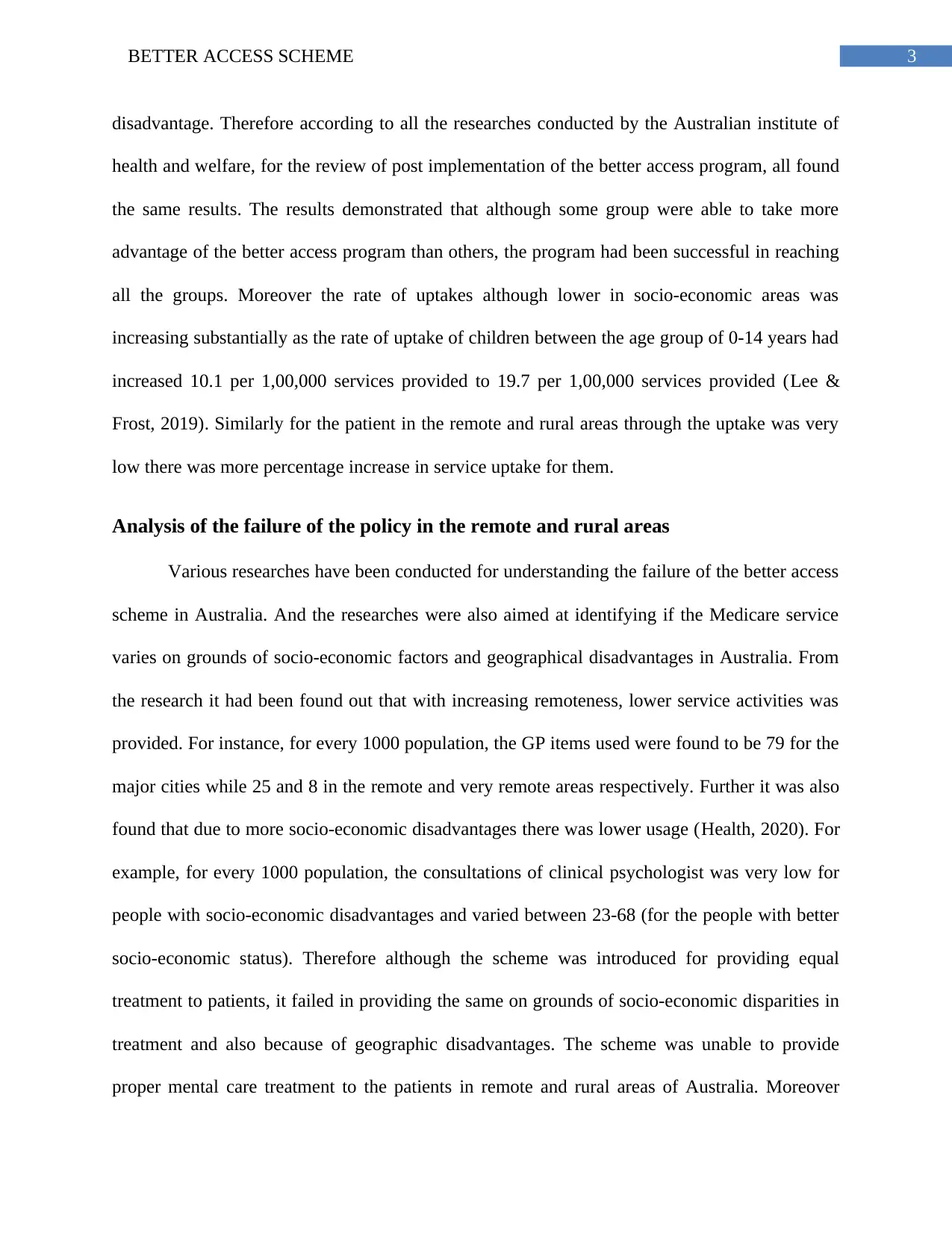
3BETTER ACCESS SCHEME
disadvantage. Therefore according to all the researches conducted by the Australian institute of
health and welfare, for the review of post implementation of the better access program, all found
the same results. The results demonstrated that although some group were able to take more
advantage of the better access program than others, the program had been successful in reaching
all the groups. Moreover the rate of uptakes although lower in socio-economic areas was
increasing substantially as the rate of uptake of children between the age group of 0-14 years had
increased 10.1 per 1,00,000 services provided to 19.7 per 1,00,000 services provided (Lee &
Frost, 2019). Similarly for the patient in the remote and rural areas through the uptake was very
low there was more percentage increase in service uptake for them.
Analysis of the failure of the policy in the remote and rural areas
Various researches have been conducted for understanding the failure of the better access
scheme in Australia. And the researches were also aimed at identifying if the Medicare service
varies on grounds of socio-economic factors and geographical disadvantages in Australia. From
the research it had been found out that with increasing remoteness, lower service activities was
provided. For instance, for every 1000 population, the GP items used were found to be 79 for the
major cities while 25 and 8 in the remote and very remote areas respectively. Further it was also
found that due to more socio-economic disadvantages there was lower usage (Health, 2020). For
example, for every 1000 population, the consultations of clinical psychologist was very low for
people with socio-economic disadvantages and varied between 23-68 (for the people with better
socio-economic status). Therefore although the scheme was introduced for providing equal
treatment to patients, it failed in providing the same on grounds of socio-economic disparities in
treatment and also because of geographic disadvantages. The scheme was unable to provide
proper mental care treatment to the patients in remote and rural areas of Australia. Moreover
disadvantage. Therefore according to all the researches conducted by the Australian institute of
health and welfare, for the review of post implementation of the better access program, all found
the same results. The results demonstrated that although some group were able to take more
advantage of the better access program than others, the program had been successful in reaching
all the groups. Moreover the rate of uptakes although lower in socio-economic areas was
increasing substantially as the rate of uptake of children between the age group of 0-14 years had
increased 10.1 per 1,00,000 services provided to 19.7 per 1,00,000 services provided (Lee &
Frost, 2019). Similarly for the patient in the remote and rural areas through the uptake was very
low there was more percentage increase in service uptake for them.
Analysis of the failure of the policy in the remote and rural areas
Various researches have been conducted for understanding the failure of the better access
scheme in Australia. And the researches were also aimed at identifying if the Medicare service
varies on grounds of socio-economic factors and geographical disadvantages in Australia. From
the research it had been found out that with increasing remoteness, lower service activities was
provided. For instance, for every 1000 population, the GP items used were found to be 79 for the
major cities while 25 and 8 in the remote and very remote areas respectively. Further it was also
found that due to more socio-economic disadvantages there was lower usage (Health, 2020). For
example, for every 1000 population, the consultations of clinical psychologist was very low for
people with socio-economic disadvantages and varied between 23-68 (for the people with better
socio-economic status). Therefore although the scheme was introduced for providing equal
treatment to patients, it failed in providing the same on grounds of socio-economic disparities in
treatment and also because of geographic disadvantages. The scheme was unable to provide
proper mental care treatment to the patients in remote and rural areas of Australia. Moreover
Paraphrase This Document
Need a fresh take? Get an instant paraphrase of this document with our AI Paraphraser
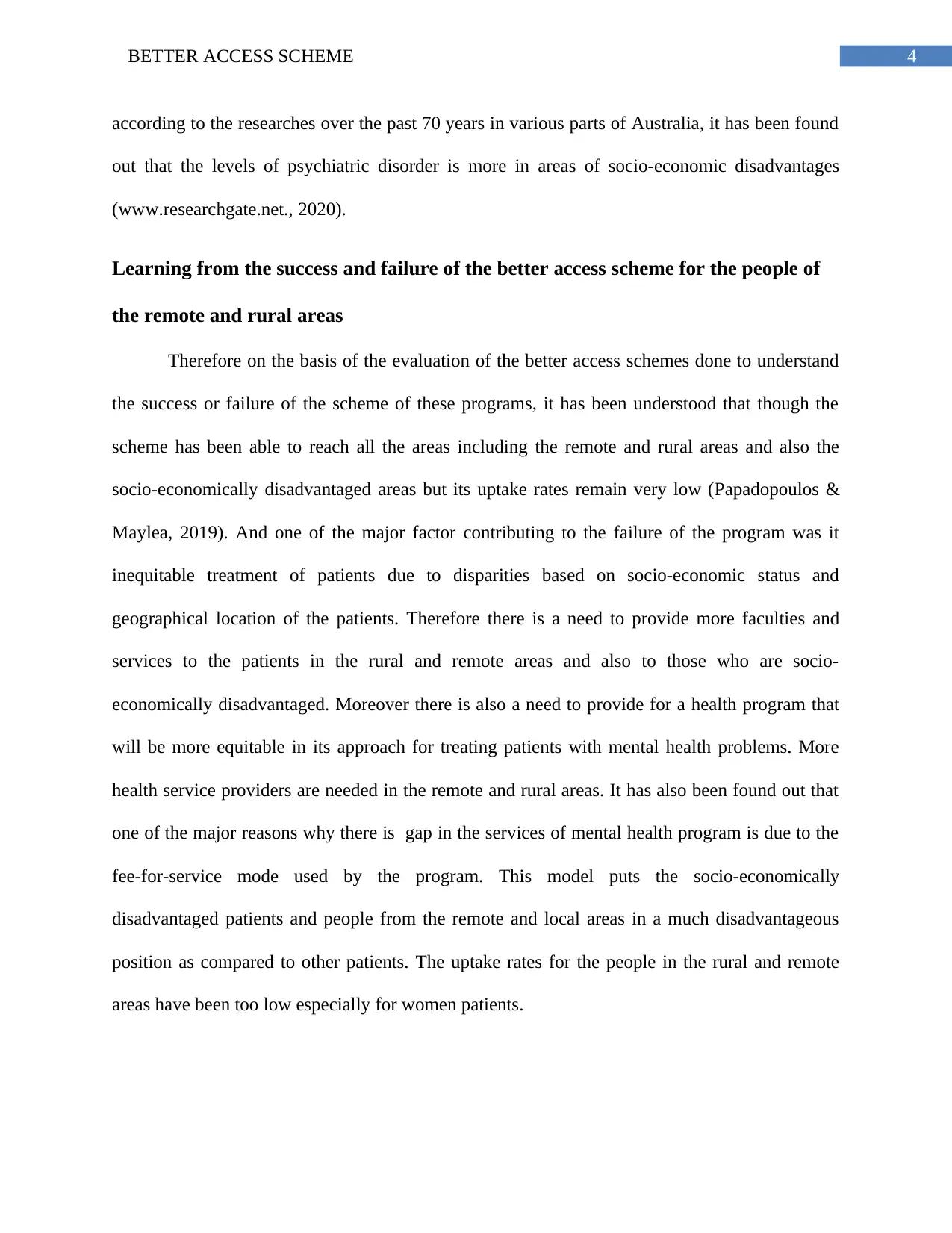
4BETTER ACCESS SCHEME
according to the researches over the past 70 years in various parts of Australia, it has been found
out that the levels of psychiatric disorder is more in areas of socio-economic disadvantages
(www.researchgate.net., 2020).
Learning from the success and failure of the better access scheme for the people of
the remote and rural areas
Therefore on the basis of the evaluation of the better access schemes done to understand
the success or failure of the scheme of these programs, it has been understood that though the
scheme has been able to reach all the areas including the remote and rural areas and also the
socio-economically disadvantaged areas but its uptake rates remain very low (Papadopoulos &
Maylea, 2019). And one of the major factor contributing to the failure of the program was it
inequitable treatment of patients due to disparities based on socio-economic status and
geographical location of the patients. Therefore there is a need to provide more faculties and
services to the patients in the rural and remote areas and also to those who are socio-
economically disadvantaged. Moreover there is also a need to provide for a health program that
will be more equitable in its approach for treating patients with mental health problems. More
health service providers are needed in the remote and rural areas. It has also been found out that
one of the major reasons why there is gap in the services of mental health program is due to the
fee-for-service mode used by the program. This model puts the socio-economically
disadvantaged patients and people from the remote and local areas in a much disadvantageous
position as compared to other patients. The uptake rates for the people in the rural and remote
areas have been too low especially for women patients.
according to the researches over the past 70 years in various parts of Australia, it has been found
out that the levels of psychiatric disorder is more in areas of socio-economic disadvantages
(www.researchgate.net., 2020).
Learning from the success and failure of the better access scheme for the people of
the remote and rural areas
Therefore on the basis of the evaluation of the better access schemes done to understand
the success or failure of the scheme of these programs, it has been understood that though the
scheme has been able to reach all the areas including the remote and rural areas and also the
socio-economically disadvantaged areas but its uptake rates remain very low (Papadopoulos &
Maylea, 2019). And one of the major factor contributing to the failure of the program was it
inequitable treatment of patients due to disparities based on socio-economic status and
geographical location of the patients. Therefore there is a need to provide more faculties and
services to the patients in the rural and remote areas and also to those who are socio-
economically disadvantaged. Moreover there is also a need to provide for a health program that
will be more equitable in its approach for treating patients with mental health problems. More
health service providers are needed in the remote and rural areas. It has also been found out that
one of the major reasons why there is gap in the services of mental health program is due to the
fee-for-service mode used by the program. This model puts the socio-economically
disadvantaged patients and people from the remote and local areas in a much disadvantageous
position as compared to other patients. The uptake rates for the people in the rural and remote
areas have been too low especially for women patients.
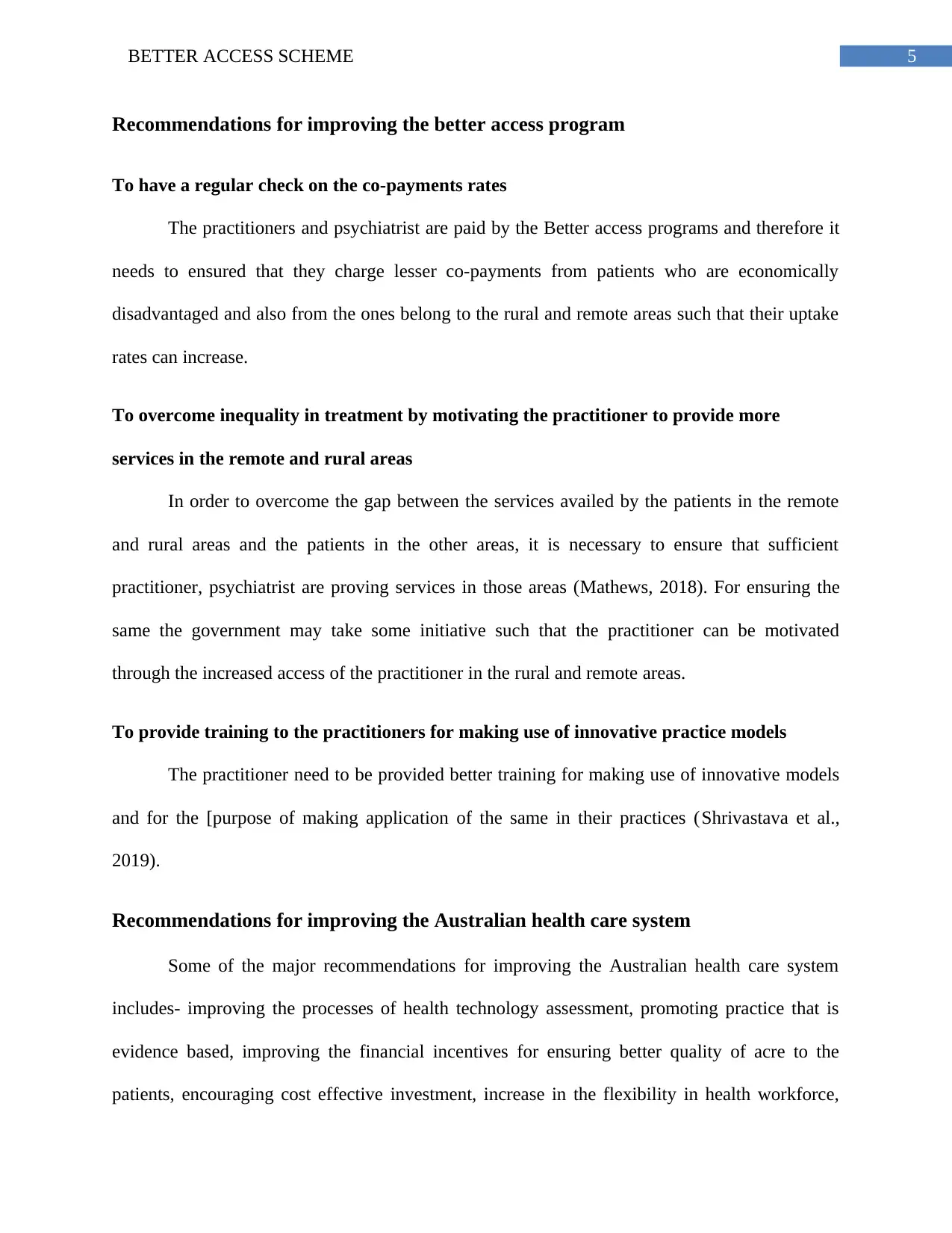
5BETTER ACCESS SCHEME
Recommendations for improving the better access program
To have a regular check on the co-payments rates
The practitioners and psychiatrist are paid by the Better access programs and therefore it
needs to ensured that they charge lesser co-payments from patients who are economically
disadvantaged and also from the ones belong to the rural and remote areas such that their uptake
rates can increase.
To overcome inequality in treatment by motivating the practitioner to provide more
services in the remote and rural areas
In order to overcome the gap between the services availed by the patients in the remote
and rural areas and the patients in the other areas, it is necessary to ensure that sufficient
practitioner, psychiatrist are proving services in those areas (Mathews, 2018). For ensuring the
same the government may take some initiative such that the practitioner can be motivated
through the increased access of the practitioner in the rural and remote areas.
To provide training to the practitioners for making use of innovative practice models
The practitioner need to be provided better training for making use of innovative models
and for the [purpose of making application of the same in their practices (Shrivastava et al.,
2019).
Recommendations for improving the Australian health care system
Some of the major recommendations for improving the Australian health care system
includes- improving the processes of health technology assessment, promoting practice that is
evidence based, improving the financial incentives for ensuring better quality of acre to the
patients, encouraging cost effective investment, increase in the flexibility in health workforce,
Recommendations for improving the better access program
To have a regular check on the co-payments rates
The practitioners and psychiatrist are paid by the Better access programs and therefore it
needs to ensured that they charge lesser co-payments from patients who are economically
disadvantaged and also from the ones belong to the rural and remote areas such that their uptake
rates can increase.
To overcome inequality in treatment by motivating the practitioner to provide more
services in the remote and rural areas
In order to overcome the gap between the services availed by the patients in the remote
and rural areas and the patients in the other areas, it is necessary to ensure that sufficient
practitioner, psychiatrist are proving services in those areas (Mathews, 2018). For ensuring the
same the government may take some initiative such that the practitioner can be motivated
through the increased access of the practitioner in the rural and remote areas.
To provide training to the practitioners for making use of innovative practice models
The practitioner need to be provided better training for making use of innovative models
and for the [purpose of making application of the same in their practices (Shrivastava et al.,
2019).
Recommendations for improving the Australian health care system
Some of the major recommendations for improving the Australian health care system
includes- improving the processes of health technology assessment, promoting practice that is
evidence based, improving the financial incentives for ensuring better quality of acre to the
patients, encouraging cost effective investment, increase in the flexibility in health workforce,
⊘ This is a preview!⊘
Do you want full access?
Subscribe today to unlock all pages.

Trusted by 1+ million students worldwide
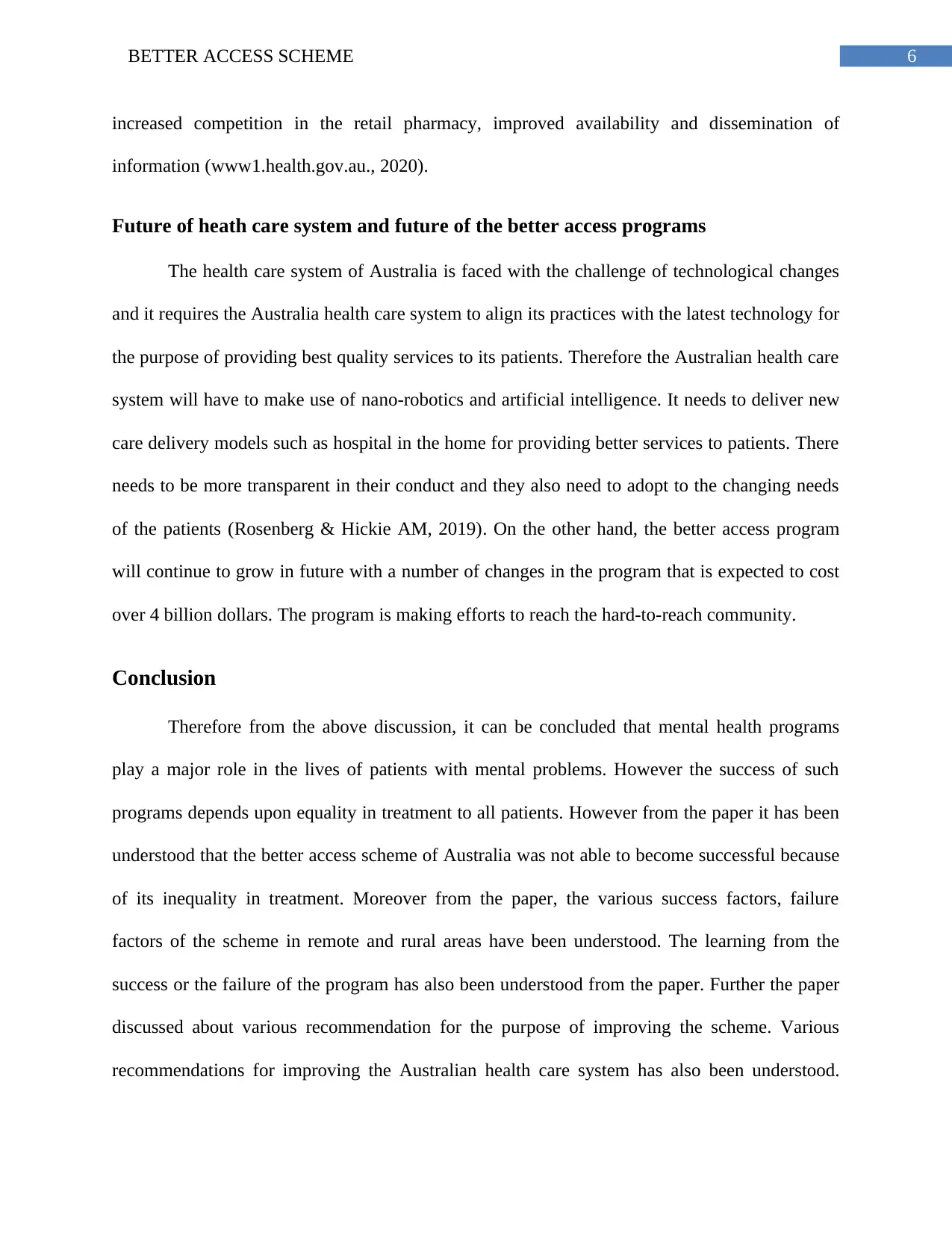
6BETTER ACCESS SCHEME
increased competition in the retail pharmacy, improved availability and dissemination of
information (www1.health.gov.au., 2020).
Future of heath care system and future of the better access programs
The health care system of Australia is faced with the challenge of technological changes
and it requires the Australia health care system to align its practices with the latest technology for
the purpose of providing best quality services to its patients. Therefore the Australian health care
system will have to make use of nano-robotics and artificial intelligence. It needs to deliver new
care delivery models such as hospital in the home for providing better services to patients. There
needs to be more transparent in their conduct and they also need to adopt to the changing needs
of the patients (Rosenberg & Hickie AM, 2019). On the other hand, the better access program
will continue to grow in future with a number of changes in the program that is expected to cost
over 4 billion dollars. The program is making efforts to reach the hard-to-reach community.
Conclusion
Therefore from the above discussion, it can be concluded that mental health programs
play a major role in the lives of patients with mental problems. However the success of such
programs depends upon equality in treatment to all patients. However from the paper it has been
understood that the better access scheme of Australia was not able to become successful because
of its inequality in treatment. Moreover from the paper, the various success factors, failure
factors of the scheme in remote and rural areas have been understood. The learning from the
success or the failure of the program has also been understood from the paper. Further the paper
discussed about various recommendation for the purpose of improving the scheme. Various
recommendations for improving the Australian health care system has also been understood.
increased competition in the retail pharmacy, improved availability and dissemination of
information (www1.health.gov.au., 2020).
Future of heath care system and future of the better access programs
The health care system of Australia is faced with the challenge of technological changes
and it requires the Australia health care system to align its practices with the latest technology for
the purpose of providing best quality services to its patients. Therefore the Australian health care
system will have to make use of nano-robotics and artificial intelligence. It needs to deliver new
care delivery models such as hospital in the home for providing better services to patients. There
needs to be more transparent in their conduct and they also need to adopt to the changing needs
of the patients (Rosenberg & Hickie AM, 2019). On the other hand, the better access program
will continue to grow in future with a number of changes in the program that is expected to cost
over 4 billion dollars. The program is making efforts to reach the hard-to-reach community.
Conclusion
Therefore from the above discussion, it can be concluded that mental health programs
play a major role in the lives of patients with mental problems. However the success of such
programs depends upon equality in treatment to all patients. However from the paper it has been
understood that the better access scheme of Australia was not able to become successful because
of its inequality in treatment. Moreover from the paper, the various success factors, failure
factors of the scheme in remote and rural areas have been understood. The learning from the
success or the failure of the program has also been understood from the paper. Further the paper
discussed about various recommendation for the purpose of improving the scheme. Various
recommendations for improving the Australian health care system has also been understood.
Paraphrase This Document
Need a fresh take? Get an instant paraphrase of this document with our AI Paraphraser
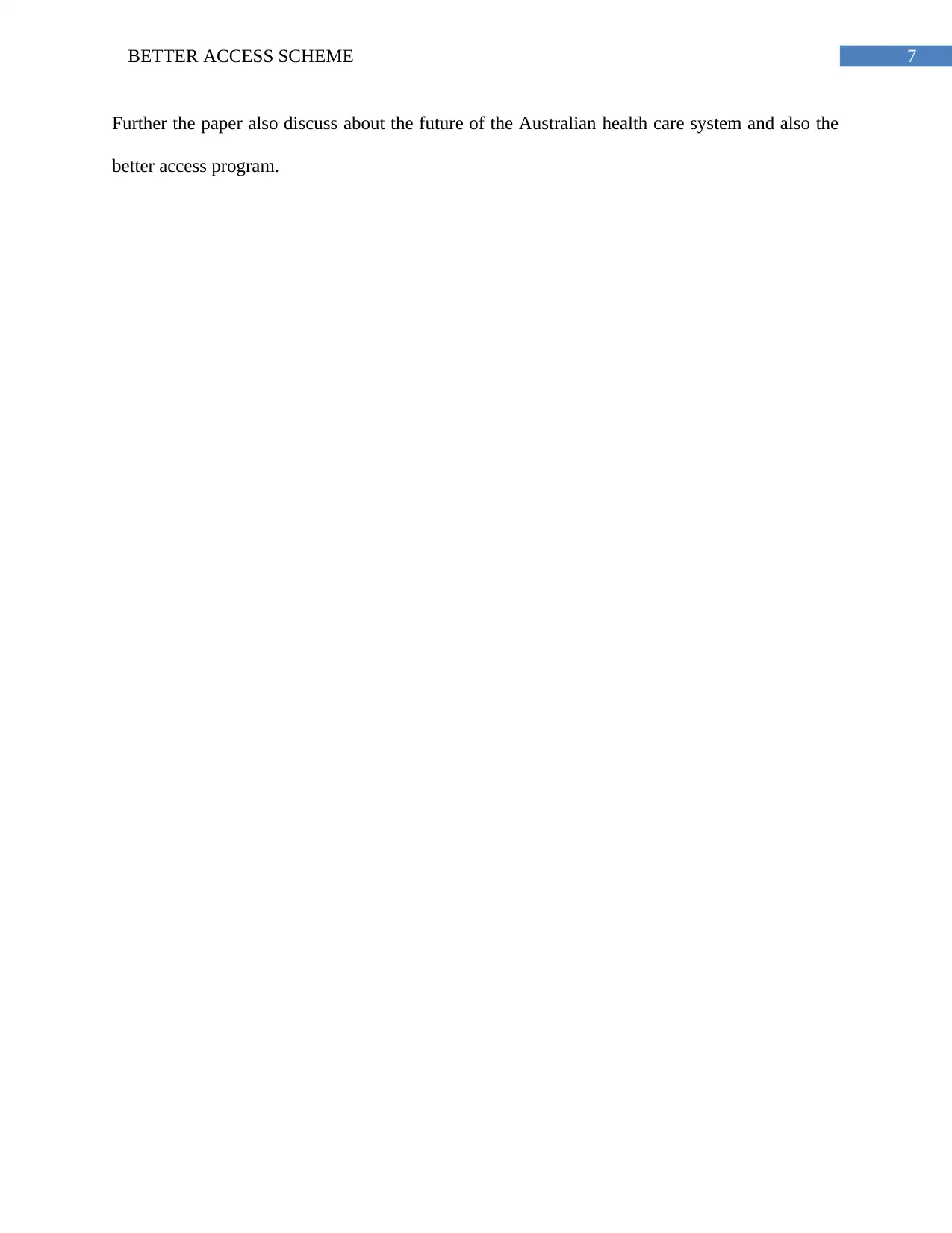
7BETTER ACCESS SCHEME
Further the paper also discuss about the future of the Australian health care system and also the
better access program.
Further the paper also discuss about the future of the Australian health care system and also the
better access program.
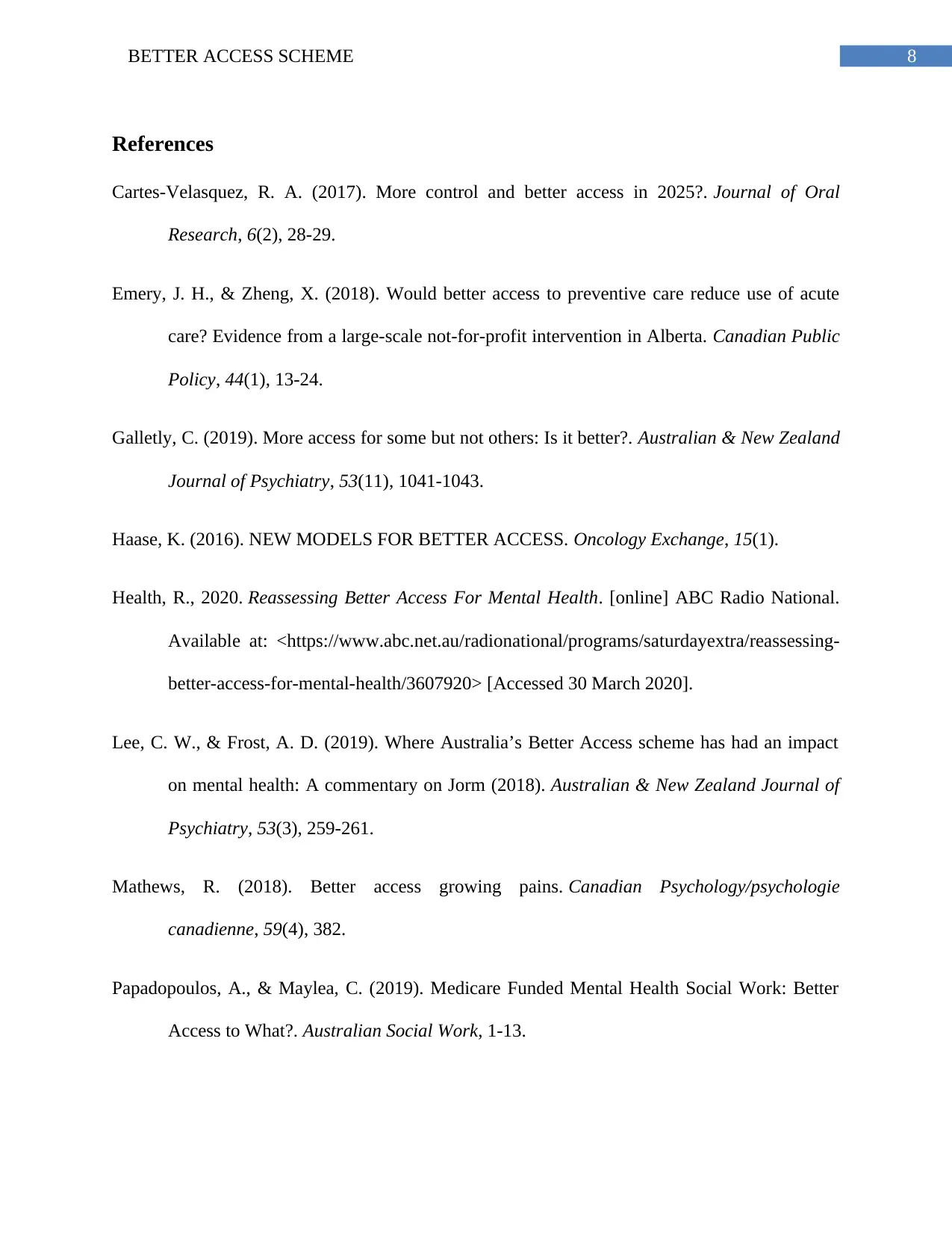
8BETTER ACCESS SCHEME
References
Cartes-Velasquez, R. A. (2017). More control and better access in 2025?. Journal of Oral
Research, 6(2), 28-29.
Emery, J. H., & Zheng, X. (2018). Would better access to preventive care reduce use of acute
care? Evidence from a large-scale not-for-profit intervention in Alberta. Canadian Public
Policy, 44(1), 13-24.
Galletly, C. (2019). More access for some but not others: Is it better?. Australian & New Zealand
Journal of Psychiatry, 53(11), 1041-1043.
Haase, K. (2016). NEW MODELS FOR BETTER ACCESS. Oncology Exchange, 15(1).
Health, R., 2020. Reassessing Better Access For Mental Health. [online] ABC Radio National.
Available at: <https://www.abc.net.au/radionational/programs/saturdayextra/reassessing-
better-access-for-mental-health/3607920> [Accessed 30 March 2020].
Lee, C. W., & Frost, A. D. (2019). Where Australia’s Better Access scheme has had an impact
on mental health: A commentary on Jorm (2018). Australian & New Zealand Journal of
Psychiatry, 53(3), 259-261.
Mathews, R. (2018). Better access growing pains. Canadian Psychology/psychologie
canadienne, 59(4), 382.
Papadopoulos, A., & Maylea, C. (2019). Medicare Funded Mental Health Social Work: Better
Access to What?. Australian Social Work, 1-13.
References
Cartes-Velasquez, R. A. (2017). More control and better access in 2025?. Journal of Oral
Research, 6(2), 28-29.
Emery, J. H., & Zheng, X. (2018). Would better access to preventive care reduce use of acute
care? Evidence from a large-scale not-for-profit intervention in Alberta. Canadian Public
Policy, 44(1), 13-24.
Galletly, C. (2019). More access for some but not others: Is it better?. Australian & New Zealand
Journal of Psychiatry, 53(11), 1041-1043.
Haase, K. (2016). NEW MODELS FOR BETTER ACCESS. Oncology Exchange, 15(1).
Health, R., 2020. Reassessing Better Access For Mental Health. [online] ABC Radio National.
Available at: <https://www.abc.net.au/radionational/programs/saturdayextra/reassessing-
better-access-for-mental-health/3607920> [Accessed 30 March 2020].
Lee, C. W., & Frost, A. D. (2019). Where Australia’s Better Access scheme has had an impact
on mental health: A commentary on Jorm (2018). Australian & New Zealand Journal of
Psychiatry, 53(3), 259-261.
Mathews, R. (2018). Better access growing pains. Canadian Psychology/psychologie
canadienne, 59(4), 382.
Papadopoulos, A., & Maylea, C. (2019). Medicare Funded Mental Health Social Work: Better
Access to What?. Australian Social Work, 1-13.
⊘ This is a preview!⊘
Do you want full access?
Subscribe today to unlock all pages.

Trusted by 1+ million students worldwide
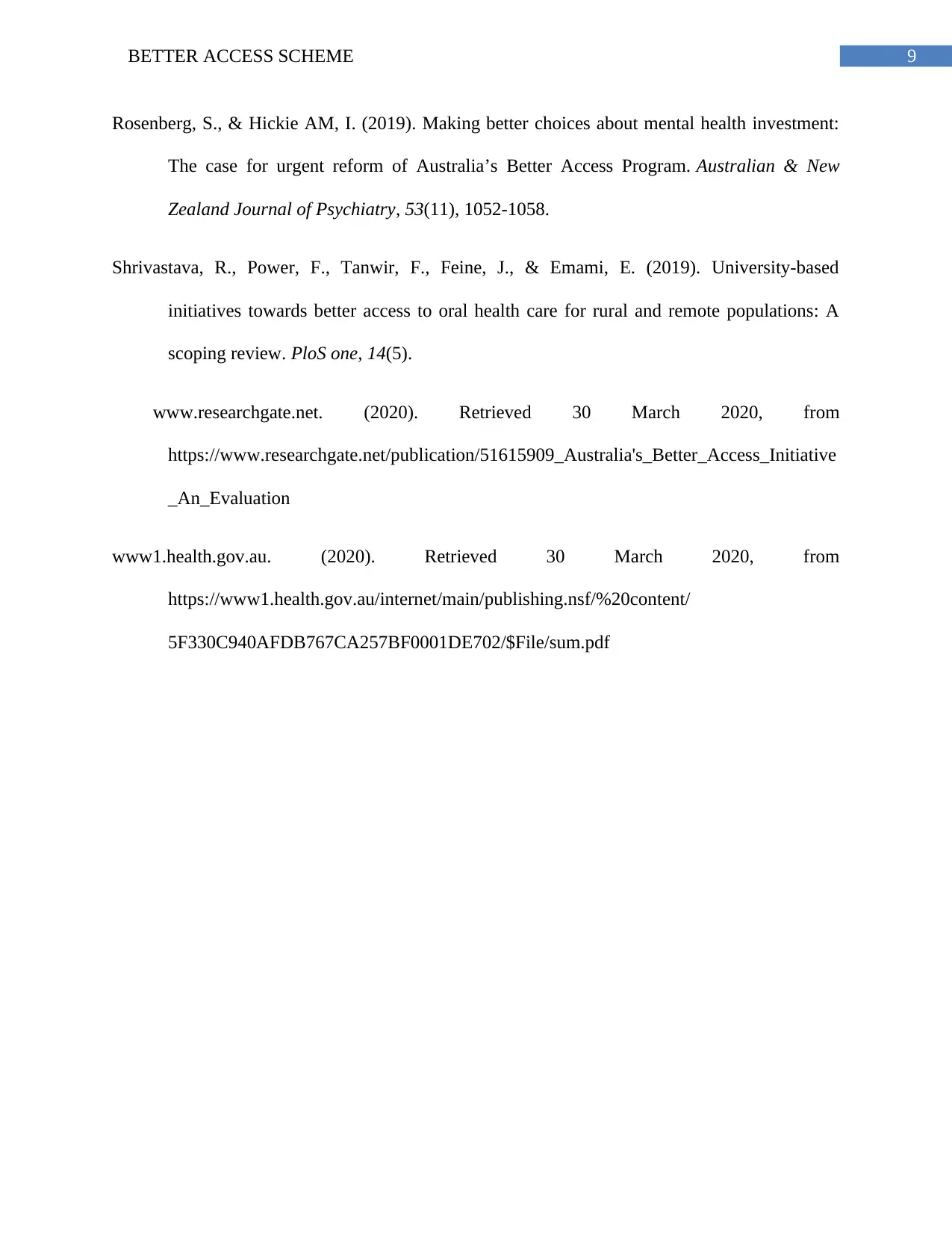
9BETTER ACCESS SCHEME
Rosenberg, S., & Hickie AM, I. (2019). Making better choices about mental health investment:
The case for urgent reform of Australia’s Better Access Program. Australian & New
Zealand Journal of Psychiatry, 53(11), 1052-1058.
Shrivastava, R., Power, F., Tanwir, F., Feine, J., & Emami, E. (2019). University-based
initiatives towards better access to oral health care for rural and remote populations: A
scoping review. PloS one, 14(5).
www.researchgate.net. (2020). Retrieved 30 March 2020, from
https://www.researchgate.net/publication/51615909_Australia's_Better_Access_Initiative
_An_Evaluation
www1.health.gov.au. (2020). Retrieved 30 March 2020, from
https://www1.health.gov.au/internet/main/publishing.nsf/%20content/
5F330C940AFDB767CA257BF0001DE702/$File/sum.pdf
Rosenberg, S., & Hickie AM, I. (2019). Making better choices about mental health investment:
The case for urgent reform of Australia’s Better Access Program. Australian & New
Zealand Journal of Psychiatry, 53(11), 1052-1058.
Shrivastava, R., Power, F., Tanwir, F., Feine, J., & Emami, E. (2019). University-based
initiatives towards better access to oral health care for rural and remote populations: A
scoping review. PloS one, 14(5).
www.researchgate.net. (2020). Retrieved 30 March 2020, from
https://www.researchgate.net/publication/51615909_Australia's_Better_Access_Initiative
_An_Evaluation
www1.health.gov.au. (2020). Retrieved 30 March 2020, from
https://www1.health.gov.au/internet/main/publishing.nsf/%20content/
5F330C940AFDB767CA257BF0001DE702/$File/sum.pdf
1 out of 10
Related Documents
Your All-in-One AI-Powered Toolkit for Academic Success.
+13062052269
info@desklib.com
Available 24*7 on WhatsApp / Email
![[object Object]](/_next/static/media/star-bottom.7253800d.svg)
Unlock your academic potential
Copyright © 2020–2025 A2Z Services. All Rights Reserved. Developed and managed by ZUCOL.





